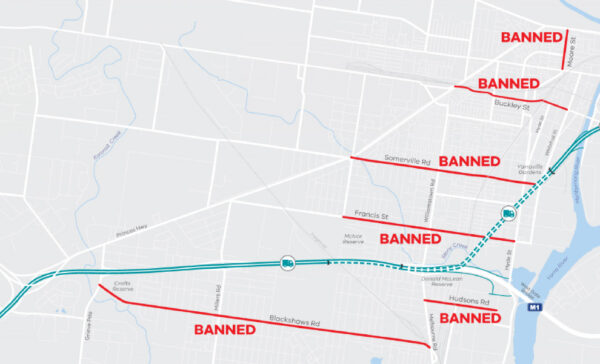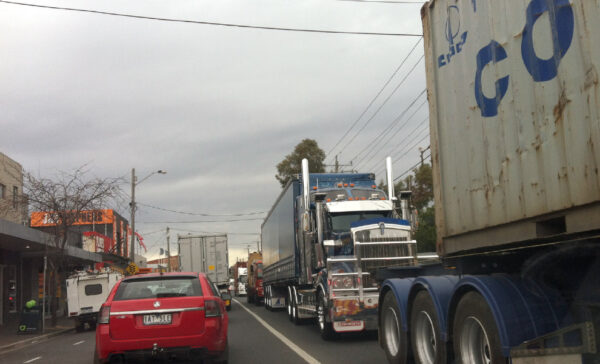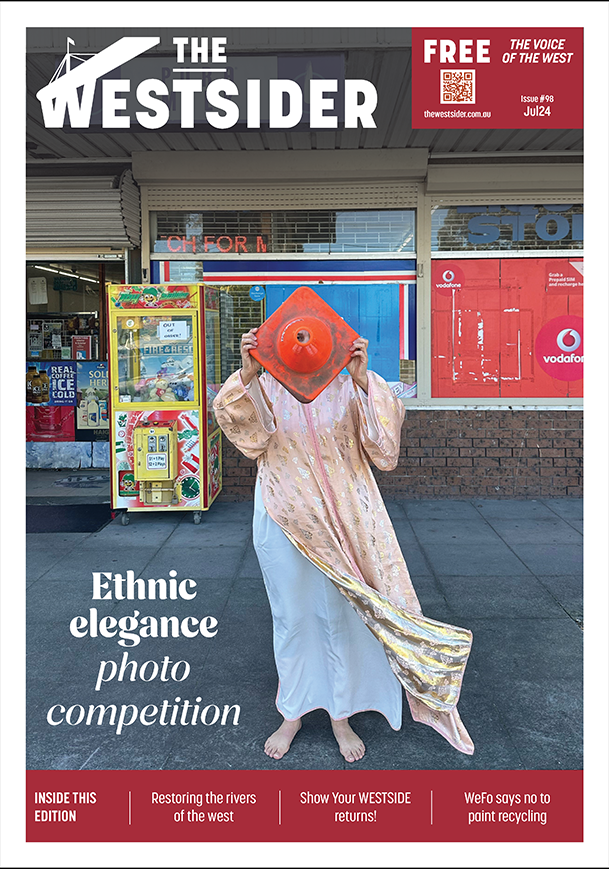By Charlotte Walkling
For many years Westies have been concerned about the adverse health effects of living in a heavily air polluted area.
Increased exposure to toxic ultrafine particles chugging out of the diesel trucks that frequent the western suburbs leads to strokes, bladder cancer, type two diabetes, asthma, coronary heart disease, and more.
Now, there are increasing studies connecting air pollution and Alzheimer’s disease.
In September last year, researchers from The University of Michigan found a link between air pollutants and dementia, and in April this year, scientists at Emory University conducted a study of over 1000 participants in Atlanta and found that high levels of air pollutants increase the chance of developing Alzheimer’s Disease.
Consolidating this research, academics at the University of Technology Sydney found that magnetite, a toxic air pollutant in diesel fumes, can lead to the development of Alzheimer’s Disease.
Our study “found that air pollution particles from diesel combustion can indeed contribute to neurodegeneration”, say Dr Kristine McGrath and Dr Cindy Gunawan, both Associate Professors in the Faculty of Science at University of Technology Sydney.
Exposure to magnetite air pollutant particles can cause an increase in neuron cell death in the area of the brain responsible for memory functions, they say.
“This exposure was also associated with memory loss, increased anxiety, and stress, which are common symptoms of Alzheimer’s Disease.”
Importantly, the study found that exposure to magnetite particles can trigger neurodegeneration regardless of pre-existing conditions.
We already know that the health impacts from air pollution are serious, but according to Martin Wurt there are still no large-scale efforts being taken by governments to protect residents in the western suburbs and beyond. He’s the President of the Maribyrnong Truck Action Group (MTAG), and has been campaigning to get trucks off residential streets in the west since 2006.
We’ve already got the highest hospital admission rates for children … If governments don’t act on that, do you think they’re really going to care about a bunch of old people with Alzheimer’s? I don’t think so.
While the new research linking air pollution to Alzheimer’s Disease is alarming, Wurt doubts it will prompt government to take any action.
“When you hear another story like this, that is now linked to Alzheimer’s, you just think, what is it going to take for the government to put a really big, concerted effort into reducing the harm of diesel emissions in our city?” he says.
“We’ve [Maribyrnong] already got the highest hospital admission rates for children. If we can’t motivate and do something about that for children … If governments don’t act on that, do you think they’re really going to care about a bunch of old people with Alzheimer’s? I don’t think so.”
One of the quickest and easiest solutions to reduce toxic air pollution from trucks in residential streets is low emission zones, says Wurt.
“That’s where you ban these older, dirtier trucks from coming into areas where we’ve got people who are more susceptible [to toxic air pollution] such as … children, kindergarten kids, primary school kids, kids who are playing outside for example.”
“You’ve only got to look to Europe, to see what low emission zones have achieved over there,” says Wurt.
Hospitals in 69 cities across Germany with low emission zones experienced a 2–3 percent decrease in patients with heart issues, and a 7–12 percent decrease in stroke patients, according to a German study conducted in 2021.

This is the type of government action needed according to researchers McGrath and Gunawan. They say the problem can only be tackled with stricter regulations on vehicle emissions and enforcement of existing air quality standards, along with investments in infrastructure improvements and public health awareness.
“A multi-faceted approach that combines regulatory measures, infrastructure investments, research initiatives, and public education efforts is necessary to effectively address the health impacts of air pollution and ensure the well-being of individuals living in heavily polluted areas.” say McGrath and Gunawan.
The Hobsons Bay City Council says it’s “taken an active and lead role in improving air quality in the inner west”. A spokesperson says Council has created a dedicated air quality webpage on a range of measures residents can take to protect themselves from poor air quality.
The Maribyrnong City Council says it‘s doing what it can to address the issue. “Council is advocating to the Federal and State Governments on a range of important issues to support improved air quality including … the introduction of low emission zones,” says Mayor Cuc Lam.
In May last year, the Maribyrnong Council even declared a health emergency in the municipality where rates of illness and hospitalisation due to air pollution considerably exceed the Australian average.
Both Councils have introduced truck curfews but have essentially washed their hands of enforcing them, saying the National Heavy Vehicle Regulator (NHVR) is responsible for evaluating individual truck permits and enforcement. But according to Martin Wurt no-one is policing the truck curfews.
“They announced traffic monitoring cameras on a couple of roads in the city of Maribyrnong. So, the idea was that they would be monitoring the curfews, but it’s just a trial … and it’s not like the cameras can issue fines or anything.”
“If I drive through a red light in my car, I’ll have a fine in my letterbox within about three days,” says Wurt, but these cameras rely “on someone looking at video footage, calling up the company that’s done the wrong thing, and telling them not to do it again.”
“It doesn’t relate to any real change on the ground.”
The NHVR says it patrols the inner-west curfew zones seven days a week with mobile patrols, and any heavy vehicle in breach of the curfew will receive appropriate enforcement action.
“The NHVR recognises the ongoing issue surrounding curfew restrictions in Melbourne’s inner-west,” according to a spokesperson, and works collaboratively with the state and local governments to explore all possible solutions which “could include Intelligence Led Camera Based Enforcement initiatives in addition to ongoing mobile patrol measures.”
But, “decisions surrounding the deployment of enforcement camera-based solutions are a matter for the Victorian Government and its departments”.
Another strategy to mitigate the risks of air pollution is to build air filtration facilities which remove some of the pollutants. While the West Gate Tunnel Project is meant to take thousands of trucks off residential streets, without proper filtration it’s a waste of time according to Martin Wurt.
“If you’re going to spend $10.8 billion, make it the best it can be, put filtration on it.”
“There are respiratory experts who are saying that even though the filtration on the vents stacks might only reduce pollution by a very small percentage, when you’ve got a population like ours which is heavily impacted already, that makes a huge, huge difference.”
“So, if we had a government that was really caring about us, they wouldn’t question putting filtration in there.”
The state government plans to incorporate a ventilation system in the tunnel to “ensure high air quality inside the tunnel” and “manage emissions from current and future traffic volumes”. But Wurt says this design is basically “an unfiltered chimney which simply dilutes the air pollution but does not remove it”.
A Hobsons Bay City Council spokesperson says it’s “lobbying the state government to install exhaust filter stacks on the West Gate Tunnel Project, including permanently funding additional air quality monitoring stations in the area.
Once the tunnel is complete, the state government will introduce a 24-hour truck ban on residential streets but residents have little to no confidence in the plan.
The Maribyrnong Truck Action Group has already documented multiple instances of trucks breaking the curfew. Recently, in a two hour period on one Sunday afternoon alone the group captured 95 curfew breakers.
“Even though we’re promised the truck bans, if the reality is the monitoring is like it is now, there’s going to be so many trucks just breaking those curfews,” says Wurt.
“The cost for a truck driver to use the new West Gate tunnel project is going to be really expensive. So, there’s going to be extra incentive for these poor [truck] owner operators who already get paid bugger all to take containers backwards and forwards from the port to not use the West Tunnel. That’s the major concern to us.”
The Australian researchers say it’s understandable that residents of heavily air polluted areas near truck routes have concerns about the health impacts of air pollution but add that individual susceptibility varies, and additional factors can influence health.
“Taking proactive measures to minimise exposure to air pollutants, such as using air purifiers indoors, avoiding outdoor activities during peak traffic times, and advocating for cleaner air policies, can help reduce potential risks,” advise Dr McGrath and Dr Gunawan.
“Additionally, continued research in this area is crucial for better understanding the full extent of the health implications and informing effective public health strategies.”
The Hon Minister Horne MP and the Department of Transport and Planning Victoria were contacted for this story but did not respond.


